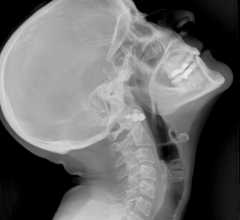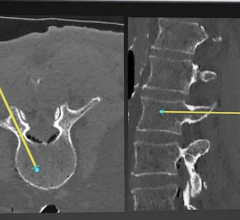
Photo courtesy of Carestream Health.
It is a question of clinical practicality. Computed radiography (CR) has traditionally offered greater flexibility in the clinical setting and at a lower cost compared to its more cumbersome and costlier digital radiography (DR) counterpart. Yet recent technological innovations have ushered in a new era for DR, delivering greater flexibility at an affordable price that rivals the clinical practicality of CR systems.
With new portable and wireless DR detectors entering the market, these breakthroughs have leveled the playing field between DR and CR, and hospitals must re-evaluate the options when purchasing an X-ray unit. Although the decision typically boils down to cost, the potential advantages and drawbacks of these competing technologies are increasingly difficult to quantify in dollar signs and merit a closer look.
DR Goes Wireless
Inside the adrenaline-charged corridors of Brant Community Healthcare System in Ontario, Canada, every second counts. The hospital deals with a heavy population base of 120,000 patients a year, many of which involve trauma cases.
“We are an acute care facility and do a number of trauma and inpatient work,” said Nancy Wheeler, imaging manager at Brant Community Healthcare System. “This involves the most difficult patients to image, and when it’s [most] important to obtain the best image quality.”
It’s precisely in these types of high-volume settings — played out in radiology and emergency departments everywhere — that DR’s efficiency and higher quality imaging presents a distinct advantage over conventional CR. When wireless capabilities are added to the mix, the benefits reach new heights.
The hospital began a three-month trial of Carestream’s DRX-1 System, a wireless DR detector that is the size of a standard cassette and can be used with existing wall stand or table-based buckys. Because the DR panels are the same size as CR plates, the wireless DR system acts as a direct replacement; no costly and time-consuming modifications to existing analog equipment are required. Hospitals considering switching radiology rooms to DR no longer have the headache or heavy investment of replacing or retrofitting all their imaging equipment to give them pause.
“This is an economical way of achieving a DR solution of great flexibility and excellent image quality,” said Wheeler. “It’s easier on the patient, it’s easier on the technologist and it’s more efficient.”
According to Wheeler, their trial experience has highlighted a number of advantages of installing wireless DR, both over CR and over traditional DR rooms. In addition to the significantly reduced cost, since detectors can be used with existing equipment instead of having to upgrade an entire room, the new wireless DR provides flexible positioning that enhances both efficiency and patient comfort.
“The DRX-1 System has resulted in an impressive 30 percent increase in efficiency at the Brant hospital,” said Wheeler. “With shorter exam times comes increased patient throughout. In fact, technologists at Brant can now preview images in five seconds, as opposed to a minute and a half with CR, where technologists had to take cassettes over to the processor, process it and return to preview. It takes 12 seconds to see the final image with the wireless DR, but the preview is what’s important. That’s where you gain efficiency.”
It has had a definite positive impact on patient diagnosis and treatment. The hospital has also been able to reduce radiation doses and improve infection control, since moving to the DR environment prevents potential cross contamination because the plates no longer leave the exam room as they would in a CR environment. The exceptional detail offered by DR is paramount when treating difficult or obese patients for whom maneuvering is tougher or even dangerous.
“It is really phenomenal,” she said. “We’re able to get imaging quality we haven’t seen in the film or CR environment.”
In particular, the hospital is seeing exceptional detail in their chest and abdomen X-rays as well as lumbar spine readings. The wireless DR system offers all the benefits of traditional DR technology — and then some. Instead of moving the patient to the DR room and propping them up on a table or chair, “we can take the imaging unit to them,” Wheeler said. “So it offers greater flexibility, and in my mind, better patient comfort.” As such, it’s absolutely poised to give CR a run for its money, said Wheeler.
“It’s not limiting. When there are systems that have be to tethered to a table or upright buckey, its very cumbersome and limiting for a technologist,” she said. “Also, we can still flip from CR to DR in this room, where in other DR-tethered environments you cannot convert easily. This remains a full functioning CR room, but we’re able to achieve an upgrade to a DR plate.”
Making the Switch
Swedish Covenant Hospital made the switch from CR to DR in June 2008 and has plans to go wireless down the road. The Chicago-based hospital, which performs about 135,000-140,000 procedures a year in radiology, has quickly climbed the digital ladder in the last five years, moving from traditional film X-rays to CR to DR and noting increased productivity along the way. Last year, the hospital installed their first DR medical systems room. They currently have seven DR systems throughout the campus, including three portables. There’s one in the emergency department, three in the outpatient center, one in a physician office and one in main radiology.
“You get better detail. It’s faster. And it’s more efficient,” said Bradley Carlton, director of radiology and PACS administrator at Swedish Covenant. “We were definitely looking for something to speed along the process; to get those patients in and out of here [faster].”
The hospital was looking to replace older systems with newer technology, as well as a means to better manage their patient throughput, said Carlton. So far, the investment is paying off, primarily in terms of staff productivity.
“The staff we currently have is able to maintain the workflow. We were going to have to add additional staffing, but now with these new rooms, we are able to maintain our current staffing levels,” he added.
The hospital currently uses the FDR Unity SpeedSuite and the FDR Velocity Speedsuite by Fujifilm Medical Systems USA. “The ability of the technologist to see the image as soon as it is taken, within seconds of the exposure, speeds up the time the patient is on the table and in the radiology department,” he said. “The technologists are spending more time taking care of the patient and less time developing film, like in the old days.” Looking ahead, Swedish Covenant is also considering going wireless. Carlton said, “We anticipate adding wireless capability in the near future.”
The Learning Curve
Since Swedish Covenant stayed with Fujifilm Medical Systems, the same vendor that supplies their current CR sytems, staff training went smoothly.
“We used the same software platform. The only thing they had to get used to was the X-ray room; we already were used to most of the equipment,” Carlton said. “Once we installed it, they were ready to go.”
Official training lasted approximately two weeks, he said. At Brant Community Healthcare System, the transition from CR to wireless DR detector was even shorter: “The learning curve was nil. The installation took half a day, the other half was spent on application training,” said Wheeler. “So halfway through the second day, we were comfortable to be on our own without any support.” Wheeler was surprised at how painless the process was. “Another feature about this software is how customizable it is as far as setting up protocols. It offers great quality assurance opportunity including statistical report creation.”
Since the hospital staff was initially reluctant to get involved with the new technology, only a small number of employees were trained in the wireless DR in the beginning. But they were soon all “wanting in on it,” said Wheeler with a laugh. “Now all the staff, whether new grads or some of our seasoned experts, everyone’s excited to get involved.”
The Case for CR
In spite of the advantages DR offers, Carlton says he doesn’t predict that it will make CR obsolete.
“I don’t see a future where there is no CR at all. There are certain examinations or views that [traditional] DR can’t be used for, like portable exams,” he said. In many cases, the decision between CR or DR would ultimately be determined by the condition and needs of the patient population and of course, the hospital’s budget.
Rob Fabrizio, marketing manager, computed radiography for Fujifilm Medical Systems USA, suggests that instead of DR ultimately replacing CR, the two systems will likely work side by side. “Cassette-based detectors will always offer portability and cost benefits not easily matched by DR panels. Today, the typical DR purchase, even with new builds, are most always complemented with CR, due to the realistic need for the convenience and flexibility of cassette exams,” Fabrizio said. “CR makes the eventual transition to DR simple, by employing the same interface, user functionality and image quality for a seamless transition from one to the other and using both together, even with the same patient study.”
CR is an essential part of every clinical imaging portfolio due to its flexibility, small footprint, portablility and low cost. Yet with significant feature enhancements making DR more clinically practical, the race is still too close to call. But one thing is clear - as DR becomes more affordable and more portable, it is quickly gaining ground on CR as the system of choice in hospitals everywhere. But CR is particularly crucial in critical exams, such as isolation, ER and OR, which require the capability of sterile bagging and disinfecting the detector/cassette if they become contaminated, which can’t happen in traditional DR rooms. The flexibility of cassettes in multiple sizes allows exams to be performed with just the right size, which is fundamental to portable, extremity, wheel chair, neo-natal and podiatric exams.
“The best image is captured with the right size, directly against the anatomy. Larger flat panel detectors (FPDs) cannot accommodate these exams well and can introduce positioning difficulties and hazards of moving the patient,” he said. As DR technology evolves, so does CR. “Digital X-ray has consistently innovated its engineering and the image capture technologies to continually push the limits in image quality, reduce equipment footprints, increase speeds, increase image resolutions and make the technology cost effective.”
Although CR may not provide the near instantaneous speeds of DR, it’s getting there: CR mages can now be displayed in as few as 15-23 seconds from the time of inserting the cassette into the reader, he added. And then there’s the omnipresent cost factor. “CR also offers the very attractive benefit of a much lower cost to implement,” said Fabrizio.



 March 19, 2025
March 19, 2025 







